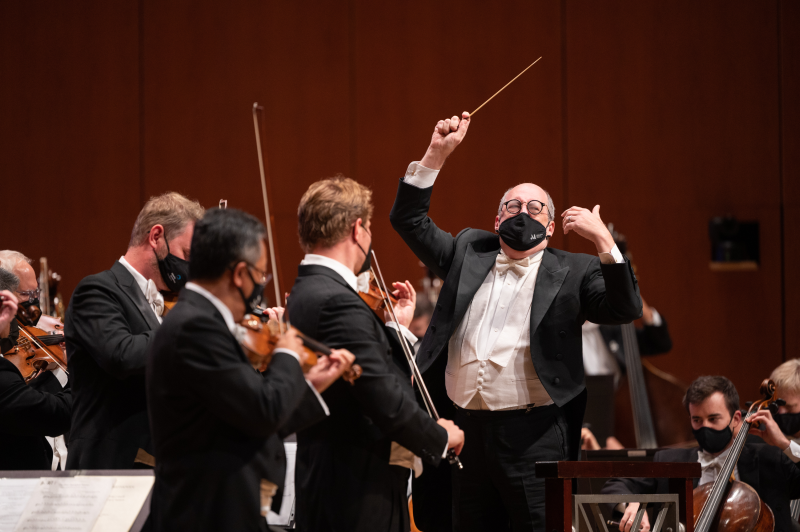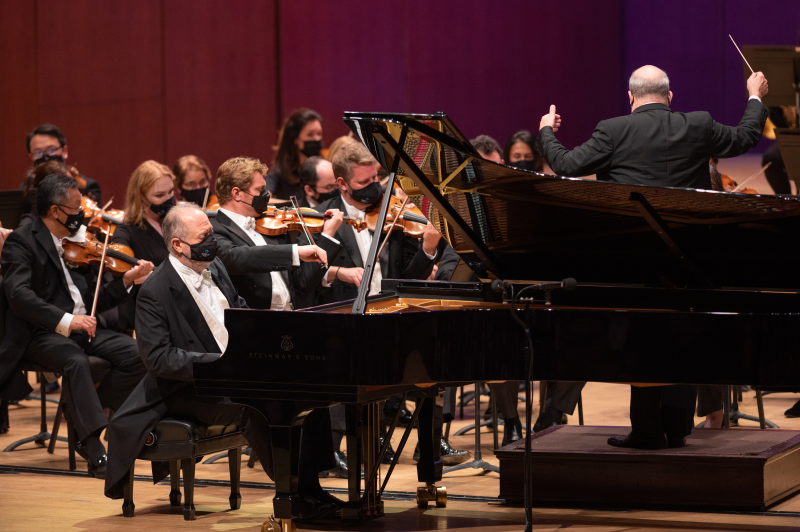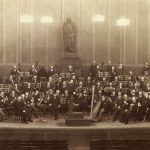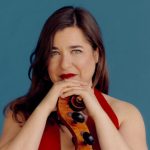September 9, 10 & 11, 2021
Atlanta Symphony Hall, Woodruff Arts Center, Atlanta, GA
Robert Spano, conductor; Garrick Ohlsson, piano.
BEETHOVEN: Symphony No. 5
BEETHOVEN: PIano Concerto No. 5
Mark Gresham | 10 SEP 2021
On Thursday evening, a sizable vaccinated and COVID-negative audience celebrated the return of live concerts by the Atlanta Symphony Orchestra. It was the launch of the ASO’s 2021-22 classical subscription series at Symphony Hall.
Audience members were required to show proof of vaccination or a sufficiently recent negative test for COVID-19, along with a photo ID, to enter the building from either side of the Galleria. Only then did they have access to Symphony Hall itself. Despite the health security checks, spirits were high in anticipation of hearing the orchestra again, live and in-person.
In the great tradition of season openers, the concert was launched with “The Star-Spangled Banner,” with the audience standing and conductor Robert Spano, who stepped down from his role as Music Director after the end of last season, turning to encourage the audience to sing along.
This time the words of the first verse (the only one anybody usually sings) felt even more relevant than usual. At the phrase “…gave proof through the night that our flag was still there,” I realized it is an analogy for where we are in the ongoing battle against COVID-19. Despite the dangers and tragic human losses, we’re still here as a society and culture and have resiliently gathered together again this evening for live symphonic music-making. Amid this ongoing night of pandemic, be of courage and hope: our flag is still there, waving.

In the great tradition: an exuberant rendition of “The Star Spangled Banner” kicked off the concert. (credit: Rand Lines)
There is little in the repertoire as iconic Beethoven’s Symphony No. 5. The opening bars have been symbolic not only of classical music but as an allegory of victory. In World War II, the rhythm of the opening four-note motif representing a “V” on Morse code. We need to keep that in mind.
Spano takes the opening bars with urgency rather than allowing a long resonant space after the fermatas. He does similarly elsewhere in the movement. His is not a lazy Allegro. Spano also seemed to for a wide dynamic range without going over the top in loud passages. But perhaps too quiet at times on the other end of the spectrum.
Perhaps it is where I was seated, and the sound of the upper winds in the orchestra was going over my head. I was not hearing them as well as I should have, their parts at times almost disappearing. Reports were that they could be more clearly heard farther back in the hall. I found this to be also the case in the second movement, where the woodwinds have a few exposed passages without strings. I may need to sit farther back in the hall next time.
The strings were benefiting from being able to sit closer together again. But there were some moments where the whole orchestra was not playing tightly as an ensemble. After all, this is essentially a new day, not just a new season: after 18 months of pandemic and a season of playing with less than full forces, distanced farther apart, it’s going to take a few concerts to fully re-adjust.
I look forward to hearing what the orchestra sounds like in another month or so.

Pianist Garrick Ohlsson performs Beethoven’s Piano Concerto No. 5 with the ASO. (credit: Rand Lines)
Garrick Ohlsson has been a longtime friend of the Atlanta Symphony Orchestra and a returning guest artist ever since his days as a young Chopin Competition winner. His first ASO appearance was in 1973 with Robert Shaw. A notable interpreter of Beethoven, Ohlsson performed the Piano Concerto No. 5 in E♭ major, Op. 73 on Thursday with assurance and ease, with all the well-considered interpretive aspects expected of the top-flight seasoned artist he is.
Here, too, the playing by the orchestra felt at its most secure.
Worth noting here that the “Emperor” has a prominent place on Ohlsson’s playlist this season. He will perform it in October, first, with the Tulsa Symphony on October 9 and Bramwell Tovey as conductor, then four times with the Dallas Symphony Orchestra, October 14-17, with Carlos Kalmar conducting.
In early May, Ohlsson will return to it again with the Madison Symphony Orchestra (WI) and its music director, John DeMain. Then in the summer, at the Bellingham Festival of Music, Ohlsson will perform all five of Beethoven’s piano concertos in three days with the Festival’s artistic director, Michael Palmer, conducting.
Ohlsson chose to play an encore that was not flashy but lyrical and contemplative: the second movement of Beethoven’s Piano Sonata No. 8 in C minor, Op. 13 (“Pathétique”). A lovely way to end the evening. ■

Mark Gresham is publisher and principal writer of EarRelevant. he began writing as a music journalist over 30 years ago, but has been a composer of music much longer than that. He was the winner of an ASCAP/Deems Taylor Award for music journalism in 2003.
RECENT POSTS







.png)